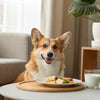Understanding What Vegetables Dogs Cannot Eat: A Comprehensive Guide for Pet Owners
- Houndsy
Table of Contents
- Introduction
- Why Understanding Dog Nutrition Matters
- The Vegetables Dogs Cannot Eat
- Safe Vegetables for Dogs
- Incorporating Vegetables into Your Dog's Diet
- The Importance of Choosing Quality Pet Products
- Conclusion
- Frequently Asked Questions (FAQs)
Introduction
As devoted pet parents, we often want to share our meals with our furry companions, believing that what is safe for us must be safe for them. However, this assumption can lead to unintended, sometimes dangerous consequences. Did you know that certain vegetables can be toxic to dogs? According to veterinary experts, the consumption of inappropriate foods can lead to serious health issues and even fatal outcomes in our beloved pets.
In this blog post, we will delve into the crucial topic of what vegetables dogs cannot eat, equipping you with the knowledge necessary to keep your canine safe and healthy. By the end, you'll understand which vegetables pose risks to dogs, why they are harmful, and what alternative treats are safe to offer. We will also explore how to enhance your dog's feeding experience, simplifying and beautifying dog care routines, much like how we at Houndsy have redefined the dog-feeding ritual with our innovative Houndsy Kibble Dispenser.
Why Understanding Dog Nutrition Matters
Dogs are omnivores, which means they can eat both animal and plant-based foods. However, not all foods that are nutritious for humans are suitable for canine companions. Understanding what vegetables dogs cannot eat is essential for several reasons:
- Health Risks: Certain vegetables can cause immediate health problems, such as gastrointestinal distress, or long-term issues, including organ failure.
- Preventive Care: Knowing what to avoid can help prevent trips to the vet, saving you time, stress, and money.
- Balanced Diet: A proper understanding of canine nutrition ensures that your dog receives a balanced diet tailored to their specific needs.
As we navigate through this topic, we invite you to reflect on your dog's feeding habits. Are there any vegetables you’ve shared with them that might be on the list of forbidden foods?
The Vegetables Dogs Cannot Eat
While many vegetables are safe and even beneficial for dogs, some should be strictly avoided. Here's a detailed look at those vegetables, including why they pose risks to our furry friends.
1. Onions and Garlic
Both onions and garlic belong to the Allium family and contain compounds known as thiosulfates, which can damage red blood cells in dogs. Symptoms of onion or garlic poisoning include weakness, vomiting, and lethargy. Even small amounts can be harmful, so it's best to keep these vegetables completely off-limits.
2. Avocado
While avocado is a healthy snack for humans, it contains a substance called persin, which can be toxic to dogs. This toxicity can lead to vomiting and diarrhea. The skin, pit, and leaves of the avocado also pose choking hazards, so it's safer to avoid this fruit entirely.
3. Mushrooms
Not all mushrooms are safe for dogs. While store-bought mushrooms like button mushrooms are generally safe, wild mushrooms can be highly toxic. Symptoms of mushroom poisoning include vomiting, diarrhea, and lethargy, and in severe cases, it can lead to organ failure. If you're unsure about a mushroom's safety, it's better to err on the side of caution and keep them away from your dog.
4. Tomatoes
Ripe tomatoes are generally safe for dogs in small amounts; however, the green parts of the tomato plant, including stems and leaves, contain solanine, which is toxic. Ingesting these parts can lead to gastrointestinal distress and other health issues.
5. Potatoes
Raw potatoes, especially when green, contain solanine, a toxin that can lead to nausea, vomiting, and even coma in dogs. Cooked potatoes are safe, but they should be served plain and without any seasonings.
6. Rhubarb
Rhubarb leaves contain oxalic acid, which can lead to kidney damage in dogs. Symptoms of rhubarb poisoning include drooling, vomiting, and difficulty breathing. Always keep rhubarb plants out of reach of curious pups.
7. Corn on the Cob
While corn itself is safe for dogs, the cob poses a significant choking hazard and can lead to intestinal blockages. If you want to share corn with your dog, only offer the kernels.
8. Chives
Similar to garlic and onions, chives are part of the Allium family and can cause damage to red blood cells. Symptoms of chive toxicity can take several days to manifest, so it's crucial to avoid them altogether.
9. Spinach
Spinach contains oxalic acid, which can interfere with calcium absorption and lead to kidney issues. While small amounts may not cause harm, it's best to limit spinach in your dog's diet.
10. Peas
Green peas are actually safe for dogs, but it's important to note that certain types of peas, like snow peas and sugar snap peas, should be given in moderation. They can lead to gas and other digestive issues.
Safe Vegetables for Dogs
Now that we understand what vegetables dogs cannot eat, let's look at some vegetables that are safe and nutritious for our canine companions. These vegetables can be excellent additions to your dog's diet:
- Carrots: High in fiber and low in calories, carrots are a crunchy snack that many dogs enjoy.
- Green Beans: Non-toxic and rich in vitamins, green beans are a great low-calorie treat.
- Cucumbers: Refreshing and hydrating, cucumbers are perfect for hot days.
- Sweet Potatoes: Cooked sweet potatoes are a good source of vitamins A and C, making them a nutritious option.
- Pumpkin: Canned pumpkin (not the spiced pie filling) can help with digestive health.
Incorporating Vegetables into Your Dog's Diet
When introducing vegetables into your dog's diet, it’s essential to do so gradually. Start with small portions to see how your dog reacts. Here are some tips for incorporating veggies safely:
- Cook When Necessary: Cooking can make some vegetables easier to digest and help release their nutrients. For example, sweet potatoes should always be cooked.
- Chop or Mash: Finely chopping or mashing vegetables can help your dog digest them more easily, mimicking how they would consume them in the wild.
- Mix with Meals: Combine vegetables with your dog's regular food to make it more enticing.
The Importance of Choosing Quality Pet Products
At Houndsy, we understand that feeding your dog should be a joyful experience—both for you and your pet. Our flagship product, the Houndsy Kibble Dispenser, is designed to simplify the feeding process. With features like perfect portion control, a large storage capacity, and a sleek design that complements modern home decor, we provide pet owners with a beautiful and practical solution for their feeding needs.
If you want to elevate your dog's feeding experience while ensuring they receive the best nutrition, consider exploring our Houndsy Kibble Dispenser.
Conclusion
Understanding what vegetables dogs cannot eat is vital for every pet owner. By being informed, we can prevent health risks and provide our dogs with a balanced diet that supports their overall well-being. Remember, the goal is to enhance their lives while minimizing any risks.
As you evaluate your pet's diet, consider their preferences and consult with your veterinarian for personalized advice. And don’t forget to check out the Houndsy Kibble Dispenser to enhance your daily feeding routine—making it convenient, consistent, and beautiful.
Frequently Asked Questions (FAQs)
1. What vegetables are safe for dogs?
Safe vegetables for dogs include carrots, green beans, cucumbers, and cooked sweet potatoes.
2. Can dogs eat corn?
Dogs can eat corn; however, the cob should be avoided due to the risk of choking and intestinal blockage.
3. What should I do if my dog eats a toxic vegetable?
If you suspect your dog has ingested a toxic vegetable, contact your veterinarian immediately for guidance.
4. Are there any fruits dogs cannot eat?
Yes, fruits such as grapes, raisins, and cherries are toxic to dogs and should be avoided.
5. How can I introduce vegetables into my dog's diet?
Introduce vegetables gradually, starting with small amounts, and monitor your dog for any adverse reactions.
By staying informed and making thoughtful choices, we can create a nourishing and safe environment for our beloved pets.













